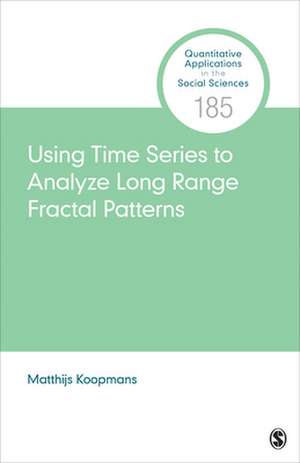Using Time Series to Analyze Long-Range Fractal Patterns: Quantitative Applications in the Social Sciences, cartea 185
Autor Matthijs Koopmansen Limba Engleză Paperback – 19 ian 2021
Din seria Quantitative Applications in the Social Sciences
-
 Preț: 306.08 lei
Preț: 306.08 lei -
 Preț: 270.02 lei
Preț: 270.02 lei -
 Preț: 270.25 lei
Preț: 270.25 lei -
 Preț: 274.06 lei
Preț: 274.06 lei -
 Preț: 270.29 lei
Preț: 270.29 lei -
 Preț: 304.51 lei
Preț: 304.51 lei -
 Preț: 304.83 lei
Preț: 304.83 lei -
 Preț: 313.80 lei
Preț: 313.80 lei -
 Preț: 305.60 lei
Preț: 305.60 lei -
 Preț: 304.77 lei
Preț: 304.77 lei -
 Preț: 306.14 lei
Preț: 306.14 lei -
 Preț: 273.46 lei
Preț: 273.46 lei -
 Preț: 275.42 lei
Preț: 275.42 lei -
 Preț: 277.33 lei
Preț: 277.33 lei -
 Preț: 305.05 lei
Preț: 305.05 lei -
 Preț: 271.10 lei
Preț: 271.10 lei -
 Preț: 270.63 lei
Preț: 270.63 lei -
 Preț: 305.05 lei
Preț: 305.05 lei -
 Preț: 304.51 lei
Preț: 304.51 lei -
 Preț: 305.28 lei
Preț: 305.28 lei -
 Preț: 305.60 lei
Preț: 305.60 lei -
 Preț: 304.77 lei
Preț: 304.77 lei -
 Preț: 306.14 lei
Preț: 306.14 lei -
 Preț: 306.34 lei
Preț: 306.34 lei -
 Preț: 305.40 lei
Preț: 305.40 lei -
 Preț: 306.41 lei
Preț: 306.41 lei -
 Preț: 304.77 lei
Preț: 304.77 lei -
 Preț: 305.60 lei
Preț: 305.60 lei -
 Preț: 304.51 lei
Preț: 304.51 lei -
 Preț: 269.91 lei
Preț: 269.91 lei -
 Preț: 270.40 lei
Preț: 270.40 lei -
 Preț: 269.91 lei
Preț: 269.91 lei -
 Preț: 289.18 lei
Preț: 289.18 lei -
 Preț: 287.82 lei
Preț: 287.82 lei -
 Preț: 316.12 lei
Preț: 316.12 lei -
 Preț: 288.96 lei
Preț: 288.96 lei -
 Preț: 316.71 lei
Preț: 316.71 lei -
 Preț: 314.98 lei
Preț: 314.98 lei -
 Preț: 317.26 lei
Preț: 317.26 lei -
 Preț: 314.60 lei
Preț: 314.60 lei -
 Preț: 289.95 lei
Preț: 289.95 lei -
 Preț: 289.18 lei
Preț: 289.18 lei -
 Preț: 315.36 lei
Preț: 315.36 lei -
 Preț: 314.98 lei
Preț: 314.98 lei -
 Preț: 314.38 lei
Preț: 314.38 lei -
 Preț: 316.33 lei
Preț: 316.33 lei -
 Preț: 316.51 lei
Preț: 316.51 lei
Preț: 270.40 lei
Nou
51.74€ • 54.27$ • 43.07£
Carte disponibilă
Livrare economică 11-25 martie
Livrare express 25 februarie-01 martie pentru 20.45 lei
Specificații
ISBN-10: 1544361424
Pagini: 120
Dimensiuni: 140 x 216 x 10 mm
Greutate: 0.14 kg
Ediția:First Edition
Editura: SAGE Publications
Colecția Sage Publications, Inc
Seria Quantitative Applications in the Social Sciences
Locul publicării:Thousand Oaks, United States
Recenzii
Each analysis is explained, and also the differences between the analyses are explained in a systematic way.
This volume offers a nice introduction to the various methods that can be used to discuss long range dependencies in univariate time series data. Koopmans makes a compelling case for these methods and offers clear exposition
This amazing book provides a concise and solid foundation to the study of long-range process. In a short volume, the author successfully summarizes the theory of fractal approaches and provides many interesting and convincing examples. I highly recommend this book.
Cuprins
Acknowledgments
About the Author
Chapter 1: Introduction
A. Limitations of Traditional Approaches
B. Long-Range Dependencies
C. The Search for Complexity
D. Plan of the Book
Chapter 2: Autoregressive Fractionally Integrated Moving Average or Fractional Differencing
A. Basic Results in Time Series Analysis
B. Long-Range Dependencies
C. Application of the Models to Real Data
D. Chapter Summary and Reflection
Chapter 3: Power Spectral Density Analysis
A. From the Time Domain to the Frequency Domain
B. Spectral Density in Real Data
C. Fractional Estimates of Gaussian Noise and Brownian Motion
D. Chapter Summary and Reflection
Chapter 4: Related Methods in the Time and Frequency Domains
A. Estimating Fractal Variance
B. Spectral Regression
C. The Hurst Exponent Revisited
D. Chapter Summary and Reflection
Chapter 5: Variations on the Fractality Theme
A. Sensitive Dependence on Initial Conditions
B. The Multivariate Case
C. Regular Long-Range Processes and Nested Regularity
D. The Impact of Interventions
Chapter 6: Conclusion
A. Benefits and Drawbacks of Fractal Analysis
B. Interpretation of Parameters in Terms of Complexity Theory
C. A Note About the Software and Its Use
References
Appendix
Index
Notă biografică
Dr. Matthijs Koopmans, professor of educational leadership, joined the faculty at Mercy College in 2011. Previously, he worked for several educational research organizations, including the Strategic Education Research Partnership Institute, Academy for Educational Development and Metis Associates. He has taught at several colleges in the greater New York metropolitan region (Hofstra University, York College/City University of New York, Adelphi University and Yeshiva University). As an independent contractor, he has conducted evaluations for MGT of America, Institute for Student Achievement, National Urban Technology Center and Newark Public Schools. In scholarship, his areas of focus are the application of complexity theory to education, cause and effect relationships, and the estimation of fractal patterns in time series data. This book pursues the latter interest, which stems from a belief that the effective application of principles of complexity theory in the social sciences should include attempts to extend conventional parametric models to the estimation of dynamical processes. He published his research in numerous peer-reviewed journals and continues to present his work at national and international scholarly conferences. He is a founding editor of the International Journal of Complexity in Education and serves on the editorial board of Nonlinear Dynamics, Psychology, and Life Sciences. He earned his Doctorate in 1988 from the Harvard Graduate School of Education.
